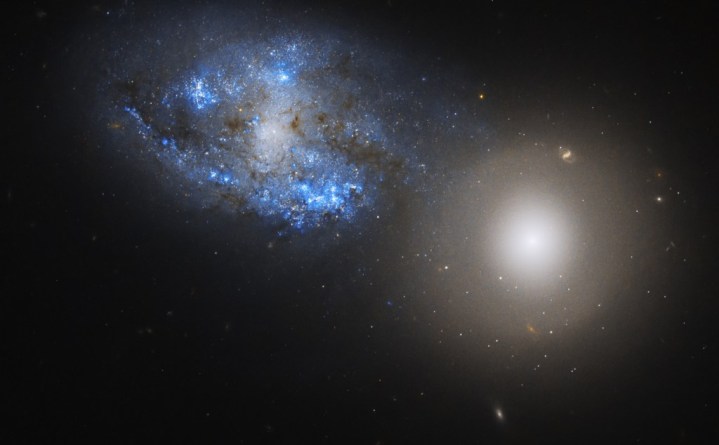When two different galaxies get close enough together that they begin interacting, they are sometimes given a shared name. That’s the case with a newly released image from the Hubble Space Telescope that shows two galaxies, NGC 274 and NGC 275, which are together known as Arp 140. not only is there a new image of the pair, but there’s also a sonification available so you can hear the image as well as see it.

Arp 140 consists of a spiral galaxy like our Milky Way on the left, and a lenticular galaxy on the right. Lenticular galaxies have a less orderly structure than spiral galaxies, appearing blob-like or unfocused, which is why this one appears as a hazy white light. A lenticular galaxy is halfway between the ordered shape of a spiral galaxy and the totally unstructured elliptical galaxy. The lenticular galaxy does have a disk shape but no spiral arms. The spiral galaxy shown here is a particular type called a barred spiral galaxy, which has a bright bar across the center where many stars are packed tight.
As well as the image, Hubble scientists also released this sonification of Arp 140. The idea is to translate the colors and brightness of the image into sound, to provide a new way to experience the stunning views collected by Hubble and other telescopes.
“Scientists sonified the data in this image, assigning pitch to color for the image as a whole (bluer light is higher, redder is lower),” NASA explains. “Pitch is mapped to brightness for the resolved stars and background galaxies, based on their apparent size – objects that appear bigger are lower, and smaller are higher in pitch. Brighter light is louder throughout the image.”
Previous sonifications by NASA have included using images from the James Webb Space Telescope, the Chandra X-ray Observatory, and other Hubble images. They have used different methods of translating color and brightness into pitch, volume, and time, and a similar project has even turned space images into sheet music that can be played.
Scientists working on the sonification have said that they aim to not only give the public a fun new way to engage with NASA imagery but also to make space images accessible to people who are blind or have low vision.
Editors’ Recommendations

